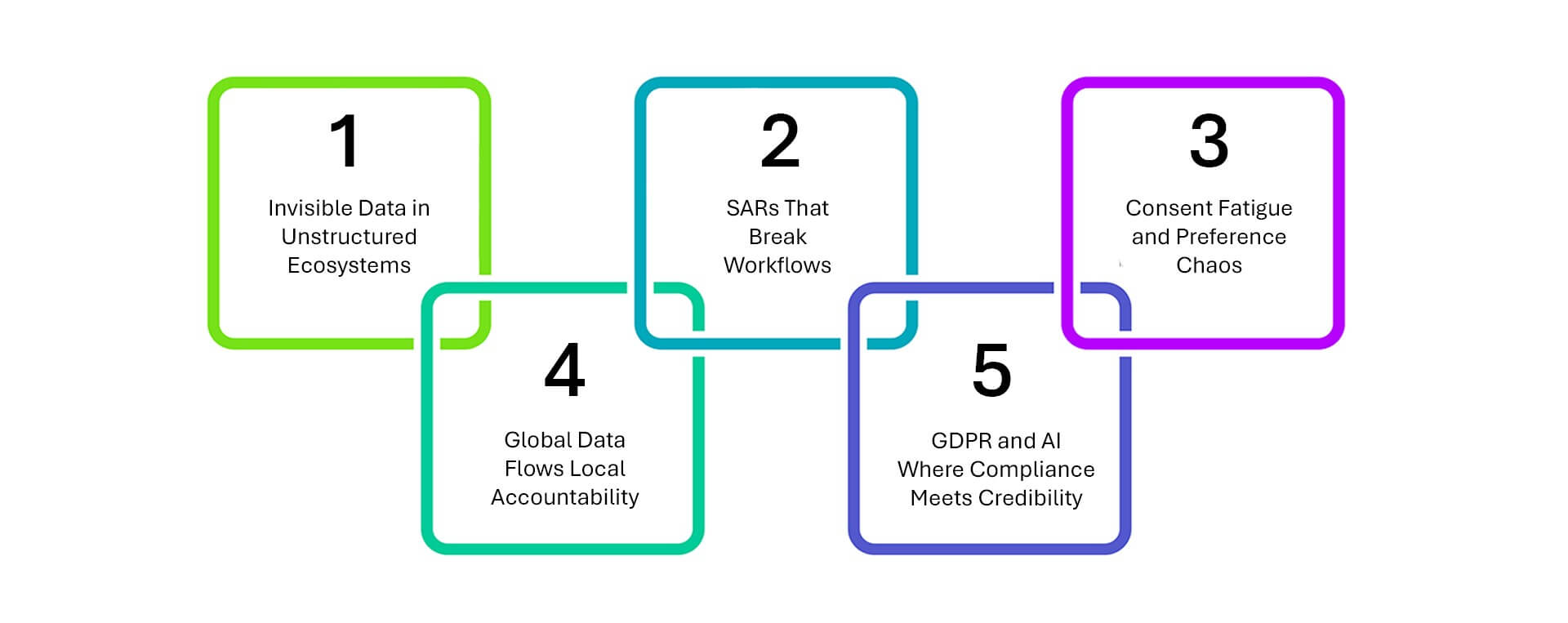What is GDPR?
The General Data Protection Regulation (GDPR) is more than a privacy law—it’s a global statement of intent: that personal data is not just information, but identity. Enforced by the European Union since May 2018, GDPR redefined the digital contract between individuals and the organizations that collect, use, and profit from their data.
It applies to any organization—anywhere in the world—that processes the personal data of EU residents. And with fines reaching up to 4% of global turnover, GDPR isn’t just another checkbox; it’s a boardroom-level imperative.
Why GDPR Still Matters—More Than Ever
Five years on, GDPR has outgrown its role as a European regulation. It’s become a global reference point—the legislative DNA of data privacy frameworks from California to Brazil to India. But its true impact lies in how it forces enterprises to confront an uncomfortable truth: if you don’t know what personal data you have, where it is, or who’s using it, you’ve already lost control.
GDPR came at a time when trust in the digital economy was beginning to erode. It introduced a new normal—where individuals are not passive subjects of surveillance capitalism, but active participants with rights, recourse, and agency. It’s reshaped how organizations design products, train AI models, manage risk, and approach ethics.
Core Principles (and Why They Matter Strategically)
- Purpose Limitation: Data should only be collected for clearly defined reasons. Strategic implication? Organizations must own their intent—vague data practices now invite penalties.
- Data Minimization: If you don’t need it, don’t collect it. Less is more—especially in the age of data breaches and AI misuse.
- Accountability: Privacy can’t be delegated. GDPR requires documented proof of compliance—a shift from passive policies to proactive governance.
- Right to be Forgotten, Right to Access, Right to Object: These aren’t just individual rights—they’re operational challenges that reveal the fragility of most legacy systems.
The Real Challenges Enterprises Face

Invisible Data in Unstructured Ecosystems
GDPR doesn’t care whether personal data lives in an email archive, a cloud repository, or a forgotten backup server. But your systems might—and that’s the problem.
What to do: Deploy intelligent discovery tools that can crawl across hybrid environments, parse unstructured content, and flag sensitive personal data—even when it’s embedded, duplicated, or mislabeled.
SARs That Break Workflows
Data Subject Access Requests (SARs) sound simple—until you realize your teams are manually combing through file shares, pulling spreadsheets, and redacting PDFs on deadline.
What to do: Automate the SAR process with context-aware platforms that extract relevant data, enforce redaction policies, and generate response packages—all with auditable workflows.
Consent Fatigue and Preference Chaos
Consent banners are everywhere. But collecting consent is easy. Proving it—tracking where it was given, for what, and by whom—is another matter entirely.
What to do: Integrate consent management directly into CRM, marketing, and product systems. Use immutable logs and version-controlled consent records to stay defensible.
Global Data Flows, Local Accountability
Cross-border data transfers—once a technical afterthought—are now a legal minefield. With the Schrems II ruling and evolving EU adequacy decisions, what’s compliant today may not be tomorrow.
What to do: Adopt sovereign-aware architectures that apply regional processing rules and encrypt personal data based on its legal jurisdiction. Combine this with legal workflow automation for DPAs, SCCs, and impact assessments.
GDPR and AI: Where Compliance Meets Credibility
As AI systems scale their reach, from personalizing services to making life-altering decisions, GDPR is no longer just a legal checkpoint. It’s the ethical backbone that separates responsible innovation from reckless automation.
Article 22 of the GDPR, which limits decisions made solely by automated processing, has become the legal embodiment of a much larger question: Can your AI be explained? Justified? Trusted? It demands more than just technical precision—it requires accountability. Not just for outcomes, but for intent.
In this context, GDPR isn’t a constraint—it’s a strategic filter. It forces organizations to confront what kind of data they use to train AI models, how that data is sourced, whether bias is being perpetuated, and whether human oversight exists in decisions that matter.
This is where regulatory compliance becomes a competitive advantage. Organizations that embed GDPR principles—transparency, fairness, purpose limitation—into their AI lifecycle are not only future-proofing against audits; they’re sending a clear message: we don’t just use data—we respect it.
And in an era where algorithms increasingly shape who gets hired, who gets a loan, or what price you pay, trust is the currency of adoption. GDPR gives enterprises the blueprint to earn it, not just from regulators, but from the people who matter most: their customers.
GDPR didn’t just give individuals more control over their data—it forced organizations to re-examine their entire relationship with it. It demands visibility, accountability, and intentionality at a level many enterprises are still struggling to achieve.
In a future powered by AI, cloud, and decentralized ecosystems, the companies that win won’t be the ones with the most data—they’ll be the ones with the cleanest, clearest, most compliant data. GDPR isn’t just about avoiding penalties. It’s about proving that your business deserves to hold someone else’s identity.
Because in the end, data privacy isn’t a checkbox—it’s a promise.
Getting Started with Data Dynamics:
- Learn about Unstructured Data Management
- Schedule a demo with our team
- Read the latest blog: UK’s Data Protection Reforms: Navigating Compliance Risks and Redefining Data Management for a New Era






